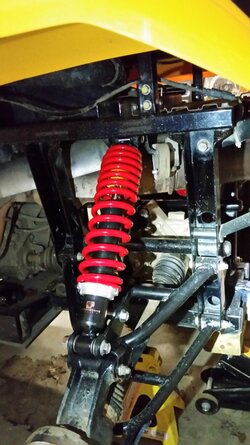My guess is that it feels stiff because the lower shock mount is moved so far out from the pivot point. Less mechanical advantage to compress that heavy spring. Seems a lower spring rate will be needed. Sorry you had to find out the hard way.
Sent from my iPhone using Tapatalk
You are absolutely right that now Chooglin has less leverage , I finally got back home and now , got a heavy s*** off my shoulders , my boards , so now I can think about anything I want.
So I draw a pic and the closer you get to the wheel the less leverage you have. With Chris C his upper point was closer to the center so he gained more leverage that way so HD is working for him better but not so much as he like also. So my guess is 429 might be a bit ok , but 425 will be plush for sure.

Found few excerpts from forums:
- " You want the top and bottom shock mounts as close as possible to the arc that the suspended end (the axle) would normally travel when it hits a bump. Normally, this is pretty close to vertical, but with the top end leaning inboard ~5-10 degrees.
The reason for this is that their effectiveness decreases proportionally to the cosine of the angle between the shock and that arc of travel."
- here is an educational video and claculations
Coilover Spring Rate Calculator (Dual Rate Spring Calculator) 
-- " In other words the rear end moves forward slightly as the suspension compresses so the shock would be straight up and down at full compression. Just a guess. I do know that the greater the angle the shock is at the less effective it is. ie, a shock mounted at 45 degrees is only like 50% effective compared to one mounted completely vertical."
---- Just as leverage between wheel and shock (created by where we mount the shock) can create a difference between wheel travel and shock travel, so to does the angle at which we mount the shock. That is, the angle at which me mount the shock creates a difference between wheel travel and shock travel.
--------------------------------------------------------------
If we mounted the shock vertically, (at an angle of 0° from vertical) then there would be no difference between shock travel and wheel travel.
For every inch the wheel goes up, the shock compresses one inch.

--------------------------------------------------------------------
Using a ludicrously extreme example for illustrative purposes:
if we mounted the shock laying flat (at an angle of 90° to vertical) then shock travel would equal 0, regardless of wheel travel.
In this configuration, no matter how much the wheel travels vertically, the shock would just pivot on its mountings, but wouldn't compress at all.
Although this example is completely impractical, it demonstrates that as the angle increases the shock travel decreases compared to wheel travel.

--------------------------------------------------------------
If we mount the shock at 45° from vertical, the relationship between shock travel and wheel travel is not so immediately apparent, although we know it depends on the angle, and we know the shock travel will be something less than the wheel travel.











